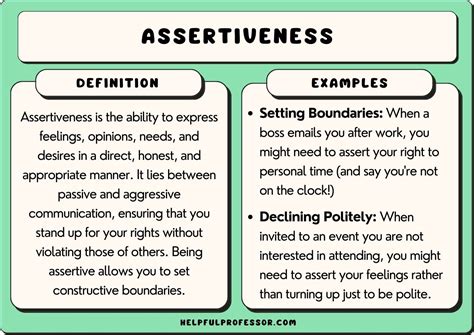
Assertiveness doesn’t have to come at the cost of likeability, according to psychologists, who have identified 12 phrases that can help individuals communicate their needs and boundaries effectively while maintaining positive relationships. These phrases, designed to foster clear communication and mutual respect, offer strategies for navigating various social and professional situations with greater confidence and poise.
Psychologists emphasize that striking a balance between assertiveness and likeability is crucial for building strong relationships and achieving personal and professional success. Assertiveness involves expressing one’s thoughts and feelings in a direct, honest, and appropriate manner, while likeability reflects the ability to connect with others and create positive social interactions. By incorporating these 12 phrases into their communication styles, individuals can enhance their assertiveness without alienating those around them.
Key Phrases for Assertive and Likable Communication
The identified phrases encompass a range of communication techniques, including expressing empathy, setting boundaries, making requests, and offering constructive feedback. Here’s a breakdown of each phrase and its intended purpose:
-
“I understand how you feel, and…” This phrase combines empathy with a clear statement of one’s own perspective. By acknowledging the other person’s emotions, you create a sense of validation and connection before presenting your viewpoint. This approach can be particularly effective in resolving conflicts or addressing differing opinions. For instance, instead of dismissing someone’s concerns outright, you might say, “I understand how you feel about the project deadline being tight, and I believe we can still meet it if we prioritize tasks effectively.”
-
“I appreciate your input, however…” This phrase acknowledges the value of someone’s contribution while gently redirecting the conversation or introducing a different perspective. It’s a useful tool for navigating discussions where you disagree with someone’s ideas without dismissing them entirely. “I appreciate your input on the marketing strategy, however, I think we should consider a more targeted approach for this particular campaign.”
-
“That’s a valid point, but from my perspective…” Similar to the previous phrase, this statement validates the other person’s viewpoint before presenting your own. It demonstrates respect for their opinion while asserting your right to hold a different perspective. This phrase is particularly helpful in collaborative settings where diverse ideas are encouraged. “That’s a valid point about reducing costs, but from my perspective, maintaining quality should be our top priority.”
-
“I’m not comfortable with that.” This is a direct and assertive way to set boundaries. It clearly communicates your limits without being apologetic or overly explanatory. It is important to be direct and firm when using this phrase, and avoids unnecessary explanations. “I’m not comfortable with sharing personal information with colleagues I don’t know well.”
-
“I need some time to think about that.” This phrase allows you to avoid making impulsive decisions or commitments. It gives you the space to consider your options carefully before responding. This is a great technique for managing expectations and preventing yourself from being pressured into something you’re not ready for. “I need some time to think about that proposal before I can make a decision.”
-
“I’m willing to compromise if…” This phrase promotes collaboration and demonstrates a willingness to find mutually agreeable solutions. It signals that you’re open to negotiation while still asserting your own needs. This is especially valuable in team settings or in personal relationships where compromise is essential. “I’m willing to compromise on the project timeline if we can allocate more resources to the critical tasks.”
-
“What I hear you saying is…” This phrase is used to confirm your understanding of the other person’s message. It shows that you’re actively listening and trying to comprehend their perspective. By paraphrasing their message, you can ensure that you’re on the same page and avoid misunderstandings. “What I hear you saying is that you feel overwhelmed with the current workload and need additional support.”
-
“My priority right now is…” This phrase clearly communicates your current focus and helps to manage expectations. It allows you to politely decline requests or postpone commitments without being dismissive. This is a helpful tool for prioritizing tasks and managing your time effectively. “My priority right now is completing the quarterly report, so I won’t be able to attend that meeting this week.”
-
“I’d prefer it if…” This phrase expresses your preferences in a polite and assertive manner. It allows you to state your needs without being demanding or aggressive. This can be very useful in navigating interpersonal interactions and setting expectations. “I’d prefer it if we could schedule meetings in the morning, as I’m more productive then.”
-
“I have a different opinion.” A simple statement that asserts your right to a different viewpoint, showing confidence without being confrontational. It is a clear, polite way to express disagreement without dismissing the other person’s perspective. “I have a different opinion on the best way to approach this problem.”
-
“I’m confident we can find a solution.” This phrase exudes optimism and confidence while acknowledging the presence of a challenge. It can be used when issues arise in your family, work, relationships, etc. It promotes a collaborative approach to problem-solving and instills a sense of hope. “I’m confident we can find a solution to this budget shortfall through creative planning.”
-
“I value our relationship.” Reinforces the importance of the relationship while addressing a conflict or disagreement. It shows that you care about the other person and want to maintain a positive connection. This can soften the blow of difficult conversations and promote mutual understanding. “I value our relationship, and I want to find a way to address this issue that works for both of us.”
The Importance of Context and Delivery
While these phrases can be valuable tools for enhancing assertiveness and likeability, psychologists emphasize that context and delivery are crucial. The effectiveness of a phrase depends on the specific situation, the relationship between the individuals involved, and the tone of voice used. For instance, using a firm and direct tone when setting boundaries (“I’m not comfortable with that”) can be more effective than using a hesitant or apologetic tone. Similarly, expressing empathy (“I understand how you feel”) can be more impactful when delivered with genuine sincerity.
According to experts, nonverbal cues, such as eye contact, body language, and facial expressions, also play a significant role in communication. Maintaining eye contact, using open and relaxed body language, and displaying a genuine smile can enhance the impact of your words and create a more positive and engaging interaction.
The Science Behind Assertive Communication
The principles behind these assertive communication techniques are rooted in psychological research on social influence, emotional intelligence, and conflict resolution. Studies have shown that individuals who communicate assertively are more likely to achieve their goals, build strong relationships, and experience higher levels of self-esteem. Assertiveness is often associated with self-efficacy, the belief in one’s ability to succeed in specific situations or accomplish a task.
Emotional intelligence, the ability to understand and manage one’s own emotions and the emotions of others, is another key factor in assertive communication. Individuals with high emotional intelligence are better able to recognize and respond to the emotional cues of others, allowing them to tailor their communication style to the specific needs of the situation.
Conflict resolution research has identified several strategies for managing disagreements effectively, including active listening, empathy, and compromise. The 12 phrases highlighted by psychologists incorporate these strategies, providing individuals with practical tools for navigating conflicts and building stronger relationships.
Building Assertiveness Skills
While some individuals may naturally possess strong assertive communication skills, others may need to develop these skills through practice and training. Psychologists recommend several strategies for building assertiveness skills, including:
- Role-playing: Practicing assertive communication techniques in simulated scenarios can help individuals become more comfortable and confident in using these techniques in real-life situations.
- Seeking feedback: Asking trusted friends, family members, or colleagues for feedback on your communication style can provide valuable insights into your strengths and areas for improvement.
- Observing assertive role models: Paying attention to how assertive individuals communicate in various situations can provide inspiration and guidance for developing your own assertive communication skills.
- Taking assertiveness training courses: These courses provide structured learning opportunities to develop assertive communication skills and address specific communication challenges.
- Self-reflection: Regularly reflecting on your communication experiences can help you identify patterns of behavior and develop strategies for improving your communication style.
- Start Small: Begin with low-stakes situations to practice using these phrases and build your confidence.
By consistently practicing and refining their assertive communication skills, individuals can enhance their ability to express their needs and boundaries effectively while maintaining positive relationships.
Benefits of Assertive and Likable Communication
The benefits of assertive and likable communication extend beyond personal relationships and professional success. Assertive communication can also contribute to improved mental health and well-being. Studies have shown that individuals who communicate assertively are less likely to experience stress, anxiety, and depression.
By setting clear boundaries and expressing their needs effectively, assertive individuals are better able to protect their time and energy, reducing the risk of burnout and emotional exhaustion. Assertiveness can also enhance self-esteem and confidence, leading to greater feelings of empowerment and control.
In the workplace, assertive communication can contribute to improved team performance, reduced conflict, and increased job satisfaction. Employees who communicate assertively are more likely to voice their opinions, share their ideas, and advocate for their needs, leading to a more collaborative and productive work environment. Assertive leaders are also more likely to inspire and motivate their teams, fostering a culture of trust and respect.
The Dark Side of Aggression and Passivity
The opposite of assertiveness includes aggression and passivity, neither of which are effective strategies for building strong relationships or achieving personal and professional goals.
Aggression involves expressing one’s needs and feelings in a hostile, demanding, or disrespectful manner. Aggressive communication often involves blaming, criticizing, or intimidating others, which can damage relationships and create conflict.
Passivity, on the other hand, involves suppressing one’s own needs and feelings to avoid conflict or please others. Passive communication often involves avoiding confrontation, agreeing with others even when you disagree, and failing to assert your boundaries.
Both aggression and passivity can have negative consequences for individuals and their relationships. Aggression can lead to social isolation, damaged relationships, and professional setbacks. Passivity can lead to feelings of resentment, low self-esteem, and unfulfilled needs.
Cultural Considerations
It’s important to note that the appropriateness and effectiveness of assertive communication can vary across cultures. What is considered assertive in one culture may be considered aggressive or disrespectful in another. For instance, in some cultures, direct eye contact is considered a sign of respect, while in others, it may be seen as challenging or confrontational.
When communicating with individuals from different cultural backgrounds, it’s important to be mindful of cultural norms and expectations. Researching cultural differences in communication styles and seeking guidance from cultural sensitivity experts can help individuals navigate cross-cultural interactions more effectively.
Refining Your Communication Style
Mastering the art of assertive and likable communication is an ongoing process. By continuously reflecting on your communication experiences, seeking feedback from others, and practicing assertive communication techniques, you can refine your communication style and build stronger relationships. Remember that assertiveness is not about getting your way all the time, but rather about expressing your needs and boundaries in a respectful and effective manner. By striking a balance between assertiveness and likeability, you can achieve your goals, build strong relationships, and live a more fulfilling life.
The Long-Term Impact of Communication Skills
The investment in developing strong communication skills, particularly the ability to be assertive while remaining likable, pays dividends throughout one’s life. From navigating complex workplace dynamics to fostering deep and meaningful personal relationships, effective communication is the bedrock of success and well-being. Individuals who master this skill set are better equipped to handle conflict, negotiate effectively, and build strong social networks. They are also more likely to be seen as leaders, collaborators, and trusted advisors. Furthermore, as noted, this skillset positively impacts mental health, reducing stress and increasing self-esteem.
Frequently Asked Questions (FAQ)
-
What is the difference between assertiveness and aggression?
- Assertiveness involves expressing your needs and opinions clearly and respectfully, while respecting the rights and needs of others. Aggression, on the other hand, involves expressing your needs and opinions in a way that is hostile, demanding, or disrespectful of others. Aggressive behavior often violates the rights and feelings of others. Assertiveness focuses on clear and direct communication, while aggression aims to dominate or control.
-
Is it possible to be too assertive?
- Yes, it is possible to be perceived as overly assertive. When assertiveness crosses the line into aggression, it can damage relationships and create conflict. The key is to strike a balance between expressing your needs and respecting the needs of others. If you find that your assertiveness is causing friction in your relationships, it may be helpful to re-evaluate your communication style and consider seeking feedback from others.
-
How can I become more assertive if I’m naturally passive?
- Becoming more assertive requires conscious effort and practice. Start by identifying specific situations where you struggle to assert yourself. Then, begin practicing assertive communication techniques in low-stakes situations. Role-playing with a friend or therapist can also be helpful. Remember to focus on expressing your needs and opinions clearly and respectfully, without apologizing or being overly accommodating. Starting small and gradually increasing the difficulty of the situations you tackle can build confidence over time.
-
Are these phrases universally applicable, or do cultural differences matter?
- While these phrases can be helpful in many situations, cultural differences do matter. What is considered assertive in one culture may be perceived as aggressive or rude in another. It’s important to be mindful of cultural norms and expectations when communicating with people from different backgrounds. When in doubt, it’s always best to err on the side of caution and seek guidance from someone familiar with the culture in question. Some phrases, like “I value our relationship,” might be more universally appreciated as they emphasize connection and respect.
-
What should I do if my attempts at assertive communication are met with resistance or hostility?
- If your attempts at assertive communication are met with resistance or hostility, it’s important to remain calm and composed. Avoid escalating the situation by becoming defensive or aggressive. Instead, try to understand the other person’s perspective and acknowledge their feelings. If the situation becomes too heated, it may be necessary to disengage and revisit the conversation at a later time. In some cases, seeking the help of a mediator or therapist may be necessary to resolve the conflict. Remember that not all communication attempts will be successful, and it’s important to prioritize your own safety and well-being. You can also calmly repeat your boundary or request, emphasizing that you are not trying to be difficult but that your need is important.









